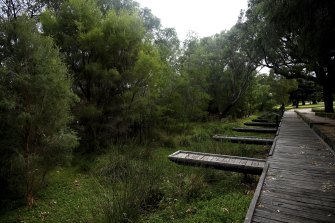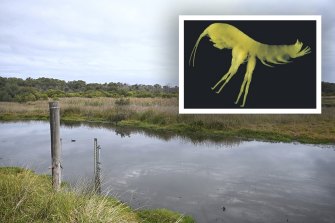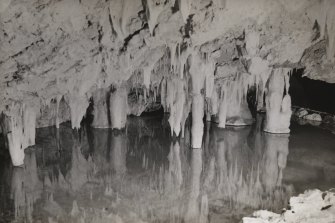Perth’s ancient shrimp link to Gondwana presumed lost
Only 20 years ago you could row a boat on Loch McNess in Yanchep National Park north of Perth.
Some of the park’s 400 limestone caves were also full of not only water but unique macroinvertebrates – water bugs big enough to see with the naked eye.
Some of these had been around since Australia was part of the supercontinent Gondwana, some 100 million years ago, and were only found in the park.
In 2022 there is no recorded trace of the cave invertebrates and the loch – also known as Lake Yanchep – has dropped by 1 metre. It now covers less than a third of its previous footprint and hugs the eastern edge.
Little jetties where rowboats were previously moored on the banks of the loch are now a good 10 metres away from the new shoreline.
Wetlands plant species on the once-submerged land between the jetty and the lake have been replaced by more terrestrial varieties.
Important plants for animal habitat, like the jointed rush, a native grass with bamboo-like stems, has disappeared from the southern banks of the lake.
Loch McNess was once one of the most diverse wetlands in Perth for invertebrates but 10, including mayfly, mite and crayfish varieties, have disappeared since 2003 when water levels started to drop dramatically.
The northern end of the wetland, which is more swampy, has dried up and a bushfire ripped along the loch’s edge and peat areas in 2019 which killed off many swamp gums and left the remaining few in poor health.
The loch and caves are reliant on rainfall and underwater aquifers but under a new Gnangara management plan, that seeks to rebalance Perth’s environmental and societal water needs, many of the lost ecological values will not be recovered.

Up until the last decade you could launch a boat on Loch McNess but now the water has receded 10 metres from these jetties.Credit:Peter de Kruijff
An Edith Cowan University report warned two years ago that a proposed drop in the state government’s minimum water level threshold for maintaining ecological values at the loch would not be enough to stop many of the environmental changes happening.
It said the proposed threshold would ensure at least one third of the lake would remain, but would not return its previous extent and conditions.
Habitat would continue to be affected, it said, particularly for the rakali or Australian water rat. Visiting birds could shift from diving birds to waders.
The current status of the nightfish, previously recorded in the loch, is unknown.
The minimum ecological threshold did end up being dropped in the new Gnangara plan from 6.95 metres above sea level to 6.2 metres – which was what the lake was sitting at in 2018-19.
ECU’s report had recommended maintaining the 6.95 metre limit and re-establishing the loch hydrogeological drivers so it had a high inflow of water.
Without this it warned the lake would transition to one of shallower nutrient enriched waters.
Department of Water and Environmental Regulation principal water planner Michael Hammond said the new management plan would either maintain or slightly improve water levels at Loch McNess.

The Crystal Cave crangonyctoid had only been found in one cave in Yanchep National Park which has now dried up. Loch McNess, the main waterbody in the park, has also seen its levels drop dramatically in recent years.
He said they had already made significant changes to groundwater management wince the ECU study was released, including working with the Water Corporation to significantly reduce a major cause of the decline: taking water for public water supply. He said there had been stabilisation in superficial levels since then.
The harvesting of the last of the pines, which will not be replaced, over the Gnangara mound is also expected to help improve water levels in Yanchep National Park, although environmentalists are worried the removal of the trees will be devastating for endangered black cockatoos.
Schrödinger’s shrimp: alive or dead?
The changes appear too late for the cave macroinvertebrates that inhabited the caves.

Crystal Cave in the Yanchep National Park used to have plenty of water for ancient invertebrates.Credit:State Library of WA
There were about 30 to 40 different species within unique ecosystems reliant on both underground streams and the root mats of tuart trees, which can stretch deep below.
One of the most unique was the Crystal Cave crangonyctoid, a tiny shrimp found in one pool of water which had been around since Australia was part of the Gondwana land mass.
The root mat-dependent ecosystem has federal protection as a critically endangered community but it is not known if any are still around.
Underground streams in accessible caves, which were reliant on the mound, started to dry up in the 1990s and attempts to pump water from nearby to maintain the stygofauna habitat failed.
The Department of Biodiversity, Conservation and Attractions previously monitored water quality and macroinvertebrates in nine Yanchep caves until 2013 but the critters have not been declared extinct as it is possible they still live in inaccessible areas.
Scientists like the late Brenton Knott were sounding warnings as far back as 1997 that Loch McNess and the caves could dry out.